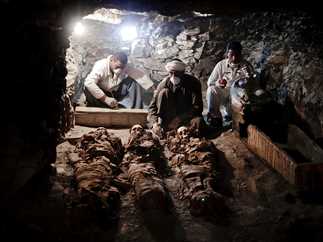
The mummification process of mummies, which Egyptian and international scholars have always attributed the procedure as an attempt to preserve bodies for the afterlife, is now nit seen as the motive behind this complex process, according to a modern British theory.
According to “The Guardian” newspaper, the mummification process was a way to transform the dead into a “form accepted by the gods.” Far from ensuring the survival of individual features, the mummification was aimed at making the occupant of the grave conform to a divine formula.
“The idea that we inherited from the Victorians, that it was all done to keep a dead body just as it was in life, is not right,” said Campbell Price, a leading Egyptologist whose book will accompany the exhibition.
“It is flawed, and we now believe it was intended to steer them towards divinity.”
Price and a team of curators of an upcoming exhibition, will invite the public to examine the evidence for themselves in the new year, when golden pharaonic mummies appear at the newly renovated Manchester Museum.
The exhibition will reopen on February 18, according to The Guardian.
The eight mummies, along with 100 other artifacts, were sent on an international tour during the closure of the museum, which will reopen again in Manchester, while Price’s interpretation of the historic embalming process will be confirmed in all its steps.
“We have to imagine a time when, not only were there obviously no photographic images, but also very few mirrors, so people didn’t know what they looked like. The whole question of individual facial features was not so important,” said Price, adding, “The ideas behind ancient portraiture and statuary were also very different as a result.”
Price now wants to discredit the colonial theory of early archaeologists:
“When people look at a face inside a mummy and say, ‘oh, they looked just like us’, it is just an illusion,” he said.
Price is an active member of the Egypt Exploration Society, which was founded in 1882 and is now challenging the old “colonial” approach.
More recent scholarly interpretations, Price said, stem in part from the work of Christina Riggs, whose recently published book “Treasured: How Tutankhamun Shaped a Century”, about the discovery of the tomb of King Tut, the famous pharaoh whose tomb was found untouched in November 1922.




